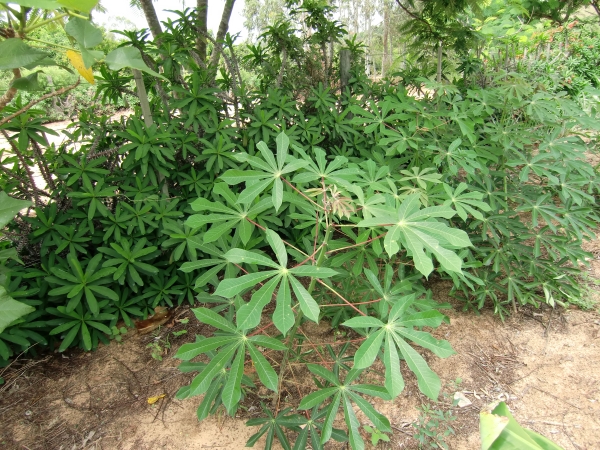

Manihot esculenta (Manioc)
One plant species from the genus Manihot and from the family Euphorbiaceae. Other names and the harvested root tubers are Mandioka, Kassava, Kassave or Yuca. The cultivation of the plant is because of its starchy root tubers very widespreaded. It is native to South America and was used by the Indias as nutrient before the discovering of America by the Europeans. Today its cultivated in the tropics and subtropics worldwide.
It forms 5 to 17 feet (1.50 to 5.00 m) tall shrubs, all parts of the plant are containing latex. Seedlings are forming at first one tap root at first. The fibrous secondary roots thicken and form large root tubers. The stems are forming different forms of growth depending on different cultivars with strong branchings from the base or with one continuous, sparse branched leading shoot. The leaves are palmated parted into three to nine segments, every is 8 to 18 cm log and 1.5 to 4 cm wide. The leaves are standing at 6 to 35 cm long leafstalks. At the ground of the leafstalk are triangularly to lanceolate secondary stipules, these are 5 to 7 mm long, they are entire or are parted into few spike-topped segments. The plant is deciduous by drought seasons, also in our garden.
The 5 to 8 cm large blossom panicles can be terminal or stand in in the leaf axils. The blossoms are male and female, both do occur on one plant. The male blossoms are consisting of five reddish sepals, which are grown together to the half of its length or less. At the inside they are haired. The female blossoms also have five heired together grown sepals, these are with 1 cm of length somewhat larger than the of the male blossoms. The fruit capsule is oval, 1.5 to 1.8 cm log and 1 to 1.5 cm wide. It has six along running ribs and contains smooth, light triangular, approx. 1 cm long seeds.
The female blossoms ripen before the male, so that the plant is not self-fertile. The blossoms contain nectar which attracts insects as pollinators. The fruit capsules pop during ripening and project the seeds.
The manioc prefers sandy or sandy-loamy soils. The growth is the best on the light acid substrate, the pH value of 4 to 8 will be tolerated, the plant does take typical tropical soils well, which do contain one high aluminium and manganese content and few available nutrients. With drought seasons the plant does not have problems, it regrows quikly again while the rainy season begins. It needs one sunny place and does not tolerate temperatures lower than 50°F (10°C).
Also the root tubers are poisonous, contain cyanhydric acid and are not suitable to eat in-kind because of this. To make it edible for the human the cyanhydric acid must be removed from the roots, already the Indians knew the possiblities for this. After precessing it can be used as manioc farina.

Manihot esculenta in our garden in December 2009.
Back to the Agricultural Plant List
Created by Joachim Jaeck on March, 10th 2010